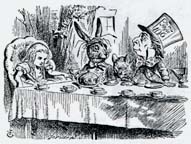
n Alice's Adventures in Wonderland (1865), Alice talks to herself just after she gulps down the bottle that was labeled "DRINK ME." Suddenly she finds herself to be extremely large in size in comparison to her miniaturized surroundings. She now considers herself "grown up." Alice exists in a double state of reality; she sees that she exists "in" a fairy tale, yet fairy tales are fantastic and unreal like the ones she used to read about. Therefore, through Alice, the reader perceives Alice's world of fantasy as reality.
This transformation of fantasy into reality created by the use of character also manifests itself in Brontë's Jane Eyre. An extraordinary event occurs the evening that Jane decided whether or not to marry St. John Rivers. Just as the tension mounts to a climax, and Jane entreats of heaven to "'Show me, show me the path!'" (369), she carefully and fantastically describes her senses and surroundings
the house was still...My heart beat fast and thick: I heard its throb. Suddenly it stood still to an inexpressible feeling that thrilled it through, and passed at once to my head and extremities. The feeling was not like an electric shock; but it was quite as sharp, as strange, as startling: it acted on my senses as if their utmost activity hitherto had been but torpor; from which they were now summoned, and forced to wake. They rose expectant: eye and ear waited, while the flesh quivered on my bones. (369)
Jane then hears a distant ethereal voice crying "'Jane! Jane! Jane!'" which did not seem to exist "...in the room — nor in the house — nor in the garden: it did not come out of the air — nor from under the earth — nor from overhead" (369). Through Jane, the reader perceives the fantastic as reality. Thus, both Lewis Carroll and Brontë use a character, to blur the concept of reality, by blurring the line between fantasy and reality.
 Carroll uses dialogue in Alice in Wonderland to reflect the passionate feelings of his character Alice. At one point, in this particular passage, she exclaims that she is in the middle of a fairy tale, she is excited and animated. These feelings th en dissipate as she realizes that she is already "grown-up," and she becomes sorrowful. Brontë, on the other hand, oftentimes does not use dialog to describe Jane's thoughts, but describes them. But, then, a voice within me averred that I could do it; and foretold that I should do it. I wrestled with my own resolution: I wanted to be weak that I might avoid the awful passage of further suffering I saw laid out for me; and conscience turned tyrant , held passion by the throat (261) Jane struggles with the dilemma of whether to leave Rochester or stay with him and be his mistress after having just learned that he already has a wife. Instead of thinking out loud to herself, as Alice often does, Jane powerfully describes a voice within herself and states what that voice tells her to do...that she should leave. Carroll and Brontë use different techniques when they want to convey the thoughts of their main characters.
Carroll uses dialogue in Alice in Wonderland to reflect the passionate feelings of his character Alice. At one point, in this particular passage, she exclaims that she is in the middle of a fairy tale, she is excited and animated. These feelings th en dissipate as she realizes that she is already "grown-up," and she becomes sorrowful. Brontë, on the other hand, oftentimes does not use dialog to describe Jane's thoughts, but describes them. But, then, a voice within me averred that I could do it; and foretold that I should do it. I wrestled with my own resolution: I wanted to be weak that I might avoid the awful passage of further suffering I saw laid out for me; and conscience turned tyrant , held passion by the throat (261) Jane struggles with the dilemma of whether to leave Rochester or stay with him and be his mistress after having just learned that he already has a wife. Instead of thinking out loud to herself, as Alice often does, Jane powerfully describes a voice within herself and states what that voice tells her to do...that she should leave. Carroll and Brontë use different techniques when they want to convey the thoughts of their main characters.
Both Jane and Alice misinterpret reality: Alice is in the middle of a fairy tale and Jane fantastically describes events. Alice almost convinces the reader that even though she exists in a fairy tale, all of her fantastic encounters with the Queen and the Mad Hatter are actually part of reality. Jane, like Alice, tries to convince the reader that a mystical event is truly real. When Jane was a young girl living in the Reed's household as a quasi-servant, Mrs. Reed sends her to a room where she must stay until she is told otherwise. In this dark and lonely room Jane describes a strange light that "...gilded up to the ceiling and quivered over my head....I thought the swift-darting beam was a herald of some coming vision from another world." (14) Jane then screams for help, and cries to Bessie the servant that she will be killed by this frightening ghost.
Content last modified May 1994